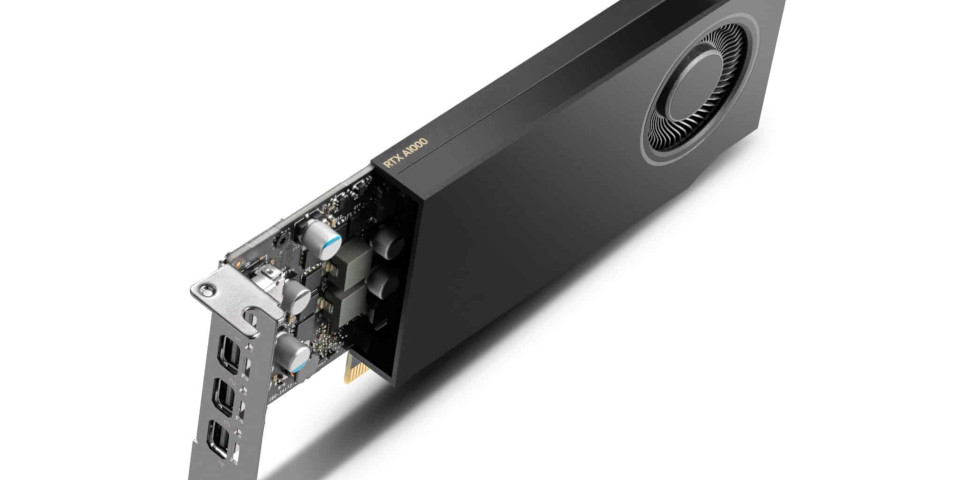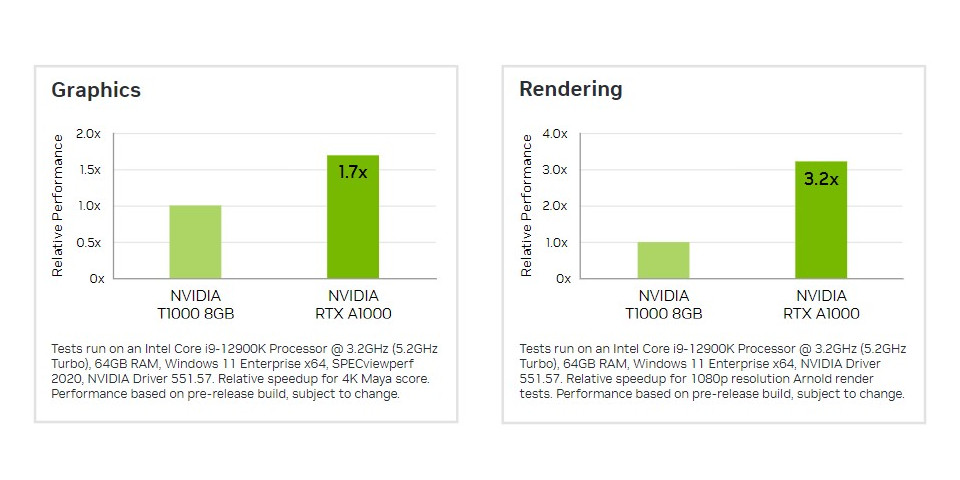NVIDIA unveils new RTX A400 and RTX A1000 pro GPUs

NVIDIA has unveiled the RTX A400 and RTX A1000, two new entry-level professional GPUs based on its previous-generation Ampere architecture.
The 4GB and 8GB single-slot cards are targeted at “a range of professional needs, from basic graphic design and photo editing to … 3D modeling”, and at generative AI.
The first Ampere workstation cards aimed at CG work since 2022
Outside of high-performance computing, the RTX A400 and RTX A1000 are the first new professional GPUs based on NVIDIA’s Ampere GPU architecture for over two years.
Although Ampere has since been superseded by the Ada Lovelace architecture – by default, NVIDIA’s product webpage for its workstation GPUs hides the Ampere cards – it does feature older versions of all three of NVIDIA’s key GPU core types: CUDA cores for general GPU computing, Tensor cores for AI operations, and RT cores for hardware-accelerated ray tracing.
| Nvidia Ampere workstation GPUs | |||||||||
|---|---|---|---|---|---|---|---|---|---|
| RTX A400 |
RTX A1000 | RTX A2000 | RTX A4000 | RTX A4500 | RTX A5000 | RTX A5500 | RTX A6000 | ||
| Architecture | Ampere | Ampere | Ampere | Ampere | Ampere | Ampere | Ampere | Ampere | |
| CUDA cores | 768 | 2,304 | 3,328 | 6,144 | 7,168 | 8,192 | 10,240 | 10,752 | |
| Tensor cores | 24 | 72 | 104 | 192 | 224 | 256 | 320 | 336 | |
| RT cores | 6 | 18 | 26 | 48 | 56 | 64 | 80 | 84 | |
| Compute performance FP32 (Tflops) |
2.7 Tflops | 6.7 Tflops | 8.0 Tflops | 19.2 Tflops | 23.7 Tflops | 27.8 Tflops | 34.1 Tflops | 38.7 Tflops | |
| GPU memory | 4GB GDDR6 | 8GB GDDR6 | 6GB/12GB GDDR6 |
16GB GDDR6 |
20GB DDR6 |
24GB GDDR6 |
24GB GDDR6 |
48GB GDDR6 |
|
| Memory bandwidth | 96 GB/s | 192 GB/s | 288 GB/s | 448 GB/s | 640GB/s | 768 GB/s | 768GB/s | 768 GB/s | |
| Graphics bus | PCIe 4.0 x8 | PCIe 4.0 x8 | PCIe 4.0 x16 | PCIe 4.0 x16 | PCIe 4.0 x16 | PCIe 4.0 x16 | PCIe 4.0 x16 | PCIe 4.0 x16 | |
| TDP | 50W | 50W | 70W | 140W | 200W | 230W | 230W | 300W | |
| Display connectors | 4 x MiniDP 1.4a | 4 x MiniDP 1.4a | 4 x MiniDP 1.4a | 4 x DP 1.4a | 4 x DP 1.4 | 4 x DP 1.4a | 4 x DP 1.4a | 4 x DP 1.4a | |
| Size (H x L) | 2.7″ x 6.4” Sngle slot |
2.7″ x 6.4” Sngle slot |
2.7 x 6.6″ Dual slot |
4.4 x 9.5″ Single slot |
4.4 x 10.5″ Dual slot |
4.4 x 10.5″ Dual slot |
4.4 x 10.5″ Dual slot |
4.4 x 10.5″ Dual slot |
|
| Launch date | 2024 | 2024 | 2021 | 2021 | 2021 | 2021 | 2022 | 2020 | |
| Launch price | N/A (Via partners) |
N/A (Via partners) |
$449 | $1,000 | N/A (Via partners) |
$2,250 | $3,600* | $4,649 | |
*Estimated street price
Key specifications
As you might expect, the new cards are less powerful than the existing Ampere GPUs – and significantly less so than the current Ada Generation cards – in most key specifications.
For context, both have a lower FP32 compute performance than NVIDIA’s GeForce GTX 1080, an eight-year-old consumer GPU still popular in the second-hand market.
At 4GB for the RTX A400 and 8GB for the RTX A1000, the on-board memory capacity is also on the low side for GPU rendering, at least for complex scenes.
The main selling points are the form factor – both are single-slot cards – and low power consumption: at 50W, both GPU’s TDP is 20W lower than the existing RTX A2000.
However, with NVIDIA not having announced recommended launch prices for the cards – both will be available through partner firms – it’s hard to assess their value for money.

Performance with CG software
NVIDIA has included performance figures in its data sheet for the RTX A1000, but only relative to the 8GB T1000, the equivalent GPU from the previous Turing generation of workstation cards.
Viewport perfomance in Maya – as measured by the SPECviewperf synthetic benchmark – is 1.7x higher for the RTX A1000 than its predecessor, while rendering performance in Arnold is 3.2x higher.
The largest relative performance increase is for generative AI, a use case that NVIDIA promotes in its blog post on the new cards, with the RTX A1000 providing 3.6x performance of the T1000.
Price and release dates
The RTX A1000 is available, starting now, via distribution partners like PNY. The RTX A400 will become available in May. NVIDIA hasn’t announced recommended launch prices.
Read Nvidia’s official announcement of the RTX A400 and RTX A1000 series GPUs
Find full specifications for the RTX A400 and RTX A1000 on NVIDIA’s website
Have your say on this story by following CG Channel on Facebook, Instagram and X (formerly Twitter). As well as being able to comment on stories, followers of our social media accounts can see videos we don’t post on the site itself, including making-ofs for the latest VFX movies, animations, games cinematics and motion graphics projects.
